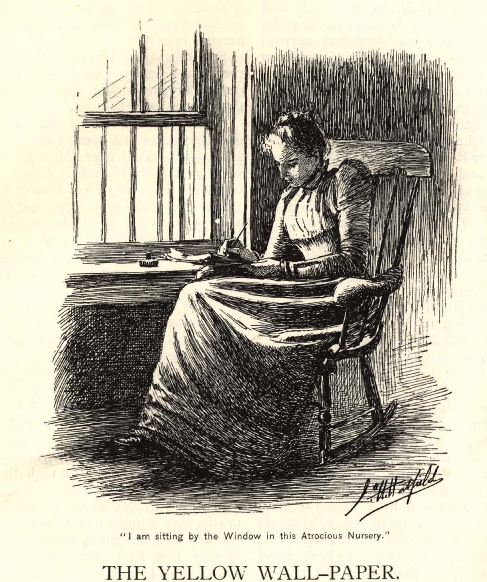Learn It Part 2
Now it’s time to take a close look at how the central idea develops over the course of “The Yellow Wallpaper,” a story written in 1892 by Charlotte Perkins Gilman. The main character is an unnamed woman, who has recently had a baby and is having difficulty getting back to normal. The details are illustrative of an era when women stayed home to take care of the home and children, and men worked and were typically regarded as the head of the household. As you read, gather details from the story to illustrate how the narrator interacts in her environment and how she describes her thoughts, feelings and surroundings. Understanding these details will help you develop a central idea statement.
Read up to the break (shown with a series of asterisks) on page 649 of “The Yellow Wallpaper.”
Go to “The Yellow Wallpaper” Opens a new window
Note: You may want to download and print the story to make notes in the margins.

In “The Yellow Wallpaper,” the narrator uses descriptive details that will help you to identify the central idea of the text.
Image credit: National Institute of Health, U.S. National Library of Medicine National Institute of HealthOpens a new window
Central Idea Tips and Questions
As you read “The Yellow Wallpaper,” take note on the following:
- The descriptive details the narrator uses to show the reader her situation and environment.
- The tone of the narrative and how it changes over the course of the story.
- The narrator’s perceptions/observations of her environment and the wallpaper as the story progresses, and why this is important.
Examine the following excerpt from the story originally on page 648.
If a physician of high standing, and one's own husband, assures friends and relatives that there is really nothing the matter with one but temporary nervous depression—a slight hysterical tendency—what is one to do?
My brother is also a physician, and also of high standing, and he says the same thing.
So I take phosphates or phosphites—whichever it is, and tonics, and journeys, and air, and exercise, and am absolutely forbidden to "work" until I am well again.
Personally, I disagree with their ideas.
Personally, I believe that congenial work, with excitement and change, would do me good.
But what is one to do?
I did write for a while in spite of them; but it DOES exhaust me a good deal—having to be so sly about it, or else meet with heavy opposition.
I sometimes fancy that in my condition if I had less opposition and more society and stimulus—but John says the very worst thing I can do is to think about my condition, and I confess it always makes me feel bad.
So I will let it alone and talk about the house.
– Charlotte Perkins Gilman, “The Yellow Wallpaper,” 1892
Reflect on the questions below, write your answers on your own paper, and click Show Answer when you are ready to check your thinking.
- What does the narrator say her doctor husband thinks is wrong with her, and what does he recommend so she can get better?
- What does the narrator think she should do to get better?
Provide details from the text.
In the same passage, the narrator says she has to be sly about writing. What does this detail tell you?
The narrator uses very descriptive language about the house. How does this language convey how the narrator feels about living there? Provide details from the text.
What evidence does the narrator give for not liking the nursery, which her husband chose as their bedroom?
What does the description tell the reader when the narrator describes the color of the wallpaper as “repellent, almost revolting: a smouldering unclean yellow”?
Provide an example from the first part of the story that illustrates John’s impatience with the narrator.
Taking into account all of the details from the beginning of the story, what central idea(s) of the text are evident up to this point?








